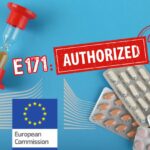
Silica, risks and health at work: update from INRS
INRS has published a practical safety sheet on synthetic amorphous silicas (SAS), their manufacture and use, their properties and hazards, as well as the prevention and protection measures to be implemented.
INRS reminds us that with 180,000 tons produced in France in 2019, SAS is one of the four most declared substances in the nanoparticulate state in the r-nano register. SAS primary particles have a diameter of less than 100 nm and are therefore, in the regulatory sense, “substances in a nanoparticulate state” or “nanomaterials”.
In short…
In vitro, SAS exerts a cytotoxic effect via oxidative stress and apoptosis (cell death). Precipitated and fumed silicas have also shown genotoxic effects (DNA breaks).
Only a few studies have looked at the carcinogenic effects of amorphous silicas, but the potential for cellular transformation as well as epigenetic effects have been reported for some.
In vivo, in rats, inhalation of amorphous silica causes pulmonary inflammation (reversible). In humans, irritation and dehydration of the mucous membranes of the nose and throat, aggravation of asthma or bronchitis, mechanical irritation and dehydration of the skin, redness and stinging of the eyes have been reported. The data are too insufficient to rule on the long-term effects of SAS on workers’ health. Hence the need to minimize occupational exposure to SAS.
The INRS practical sheet proposes detailed prevention measures adapted to each work situation:
Upcoming Nano Agenda

- Scientific conference
- 23rd International conference on Advanced Nanomaterials
- From July 23 to July 25, 2025
- Website: www.advanced-nanomaterials-conference.com

- E-learning program: awareness-raising for personnel who come into contact with nanomaterials during research, formulation, production, maintenance, cleaning, upkeep, etc., as well as safety coordinators or engineers, facility managers, heads of laboratories where nanoparticles are handled.
- Organizers: INSTN Grenoble (CEA)
- On the program:
- 1 – Introduction, definition and characteristics of nanomaterials
- 2 – Toxicity of nanomaterials: the state of knowledge
- 3 – Metrology and characterization of nanomaterials
- 4 – Prevention and protection against nanomaterials in the workplace
- 5 – Quiz: assessment of learning outcomes
- The 2-hour course can be viewed for one month from the date of registration.
- Website: https://instn.cea.fr/…risques-lies-aux-nanomateriaux…

- E-learning program: awareness-raising for personnel who come into contact with nanomaterials during research, formulation, production, maintenance, cleaning, upkeep, etc., as well as safety coordinators or engineers, facility managers, heads of laboratories where nanoparticles are handled.
- Organizers: INSTN Grenoble (CEA)
- On the program:
- 1 – Introduction, definition and characteristics of nanomaterials
- 2 – Toxicity of nanomaterials: the state of knowledge
- 3 – Metrology and characterization of nanomaterials
- 4 – Prevention and protection against nanomaterials in the workplace
- 5 – Quiz: assessment of learning outcomes
- The 2-hour course can be viewed for one month from the date of registration.
- Website: https://instn.cea.fr/…risques-lies-aux-nanomateriaux…






